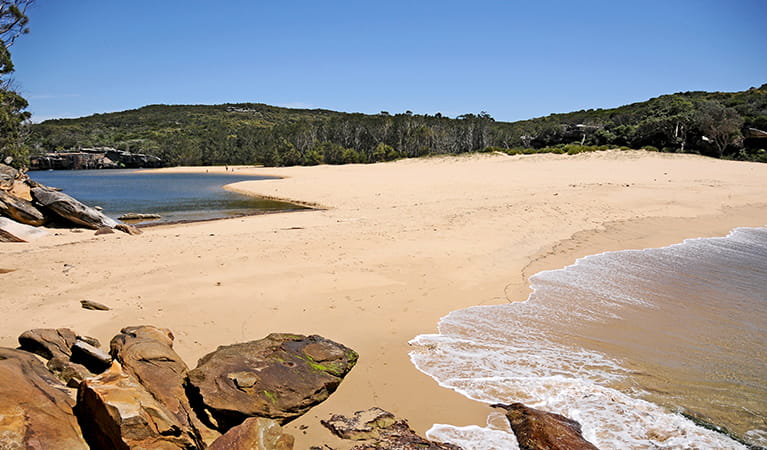School excursion
Biophysical interactions at Wattamolla
Royal National Park
Affected by closures, check current alerts
Overview
Senior students will hone their fieldwork skills in this Stage 6 (Years 11-12) Geography excursion at Wattamolla. Located in Royal National Park, Wattamolla offers students a complex site to study biophysical interactions.
Read more about Biophysical interactions at Wattamolla
Students will observe first-hand the biophysical processes that influence this coastal environment of beach, rocky platforms and freshwater creek. We'll discuss the 4 spheres that shape and impact this landscape.
Students will undertake a scientific investigation to determine biotic and abiotic factors here. They'll use their surveying and mapping skills to form a comprehensive audit of the site and the factors impacting it.
As mock land managers they'll determine the best approach for sustainable management of visitation. Their prescribed role will be to reduce the negative impact on this sensitive coastal ecosystem.
For program outline, safety and practical information about this excursion, see info for teachers
| Stage | Stage 6 (Years 11-12) |
|---|---|
| Learning area | Geography |
| Student outcomes |
GE-11-02. Explains geographical processes and influences, at a range of scales, that form and transform places and environments GE-11-04. Assesses responses and management strategies, at a range of scales, for sustainability GE-11-07. Applies geographical inquiry skills and tools, including spatial technologies, fieldwork and ethical practices, to investigate places and environments GE-12-02. Analyses geographical processes and influences, at a range of scales, that form and transform places and environments GE-12-04. Evaluates responses and management strategies, at a range of scales, for sustainability GE-12-07. Selects and applies geographical inquiry skills and tools, including spatial technologies, fieldwork and ethical practices, to investigate places and environments |
| Objectives |
Students will:
|
Excursion details
- When
Weekdays during school term.
- Availability
- Guided. Available on request.
- Duration
- 4hrs
- Grading
- Medium. Guided activities along a beach, across sand dunes and along a creek.
- Price
-
$20 per student for groups of 25 or more. GST included. For smaller groups conditions apply.
- Accessibility
- No wheelchair access
- Equipment
provided - Yes. All field equipment provided.
- Booking
- If you would like to organise a NPWS school excursion please get in touch with local staff or use the 'Enquire' link for the online form.
Local alerts
For the latest updates on fires, closures and other alerts in this area, see https://www.nationalparks.nsw.gov.au/education/stage-6-geography-biophysical-interactions-wattamolla/local-alerts
Operated by
- School excursion inquiries - Sydney South
- 02 9542 0615
- npws.royalguidedtours@environment.nsw.gov.au
- PO Box 144, Audley NSW 2232
Park info
- in Royal National Park in the Sydney and surrounds and South Coast regions
Royal National Park is open 7am to 8.30pm but may have to close at times due to poor weather or fire danger.
-
Park entry fees:
$12 per vehicle per day. Payment options include Audley Visitor Centre, vehicle entry stations, pay machines and the Park’nPay app.
Vehicles over 8 seats: $4.40 per adult, $2.20 per child (per day). Teachers/educational supervisors: free (1 adult per 10 students).
Buy annual pass.
Info for teachers
All the practical information you need to know about Biophysical interactions at Wattamolla.
Program outline
- Welcome, acknowledgement of Country and safety talk
- Observe and discuss development of the carpark and surf club area
- Morning tea and toilet break
- Conduct a field sketch of the site
- Measure and compare abiotic factors of fore dune and hind dune
- Dip-net in a freshwater creek to determine ecosystem health
- Predict the influence of sea level rise on the freshwater environment
- Examine physical processes shaping the landscape
- Return walk to shaded area for lunch
- Conduct a vegetation transect along a dune
- Assess current management strategies through a role-play scenario
- Farewell and depart on bus
Getting there and parking
Get driving directions
Wattamolla picnic area is in the eastern precinct of Royal National Park. To get there:
From Audley:
- Drive across Audley Weir and continue along Sir Bertram Stevens Drive for approximately 11km
- Turn left onto Wattamolla Road, 250m past Bundeena Drive, and follow to Wattamolla picnic area.
From Waterfall:
- Follow McKell Avenue to the end
- Turn left onto Sir Bertram Stevens Drive and continue for approximately 9km
- Turn right onto Wattamolla Road and follow to Wattamolla picnic area
Road quality
- Sealed roads
Vehicle access
- 2WD vehicles
Weather restrictions
- All weather
Parking
Parking is available.
What to bring
Please wear fully enclosed shoes and bring a hat, sunscreen, wet weather gear, and lunch which should be low waste with a refillable water bottle. Students should bring gear in a backpack or similar (not plastic bags). Please note: Students should have their own copy of the excursion worksheet, a clipboard and pencil.
Maps and downloads
Risk assessment and risk benefits
Our rangers and guides have the technical skill and experience to assess the risks and the benefits of a variety of activities delivered as part of our learning programs.
We believe in including opportunities that allow students to learn and experience for themselves through exploration in the natural environment.
Please make your own risk assessment based on the information provided. Detailed potential risks and controls are provided for the site to assist teachers in risk management planning. Teachers and carers should be aware of, and consider the needs, abilities and medical conditions of students when visiting this site. The supervision of students remains the responsibility of the teacher. The school must ensure an adequate number of adult supervisors are present.
Accessibility
Disability access level - no wheelchair access
There is no wheelchair access available. If you have someone with special needs, please let us know in advance so that we can plan accordingly.

